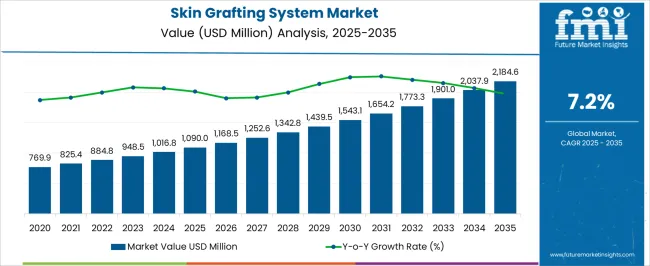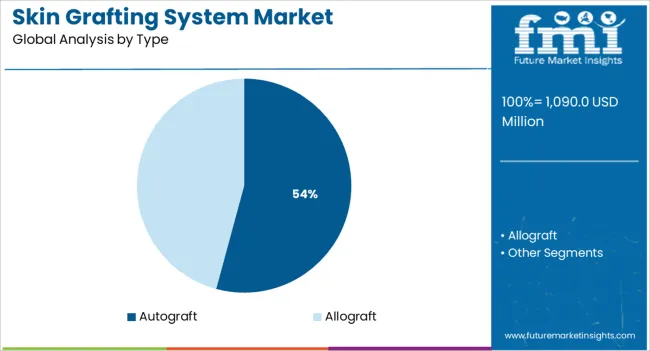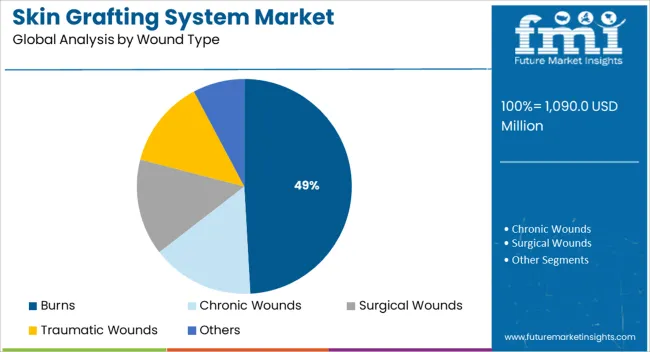The Skin Grafting System Market is estimated to be valued at USD 1090.0 million in 2025 and is projected to reach USD 2184.6 million by 2035, registering a compound annual growth rate (CAGR) of 7.2% over the forecast period.

| Metric | Value |
|---|---|
| Skin Grafting System Market Estimated Value in (2025 E) | USD 1090.0 million |
| Skin Grafting System Market Forecast Value in (2035 F) | USD 2184.6 million |
| Forecast CAGR (2025 to 2035) | 7.2% |
The skin grafting system market is experiencing consistent growth due to rising incidences of chronic wounds, burns, and reconstructive surgeries, along with technological advancements in surgical instruments. An increase in traumatic injuries, age related skin disorders, and diabetic ulcers has intensified demand for effective skin restoration procedures.
Innovations in grafting techniques, precision tools, and portable equipment are enabling faster healing and reduced surgical complications. Furthermore, the growing awareness among patients and medical professionals about the benefits of early intervention and advanced wound care is contributing to market expansion.
Healthcare infrastructure improvements, particularly in developing economies, and increasing accessibility to specialized treatments are also shaping the market landscape positively. As personalized treatment approaches and minimally invasive surgical tools gain traction, the market for skin grafting systems is expected to witness sustained adoption across diverse clinical applications.
The market is segmented by Product, Type, Wound Type, and End User and region. By Product, the market is divided into Dermatomes, Wound Debridement Devices, Skin Graft Mesher Equipment, Accessories, and Others. In terms of Type, the market is classified into Autograft and Allograft. Based on Wound Type, the market is segmented into Burns, Chronic Wounds, Surgical Wounds, Traumatic Wounds, and Others. By End User, the market is divided into Ambulatory Surgical Centers, Hospitals, and Specialty Clinics. Regionally, the market is classified into North America, Latin America, Western Europe, Eastern Europe, Balkan & Baltic Countries, Russia & Belarus, Central Asia, East Asia, South Asia & Pacific, and the Middle East & Africa.
The dermatomes segment is projected to contribute 47.60 percent of total revenue by 2025 in the product category, emerging as the leading segment. This dominance is attributed to its precision in harvesting uniform skin layers and its adaptability across different grafting procedures.
Dermatomes are widely favored in hospitals and burn care units due to their efficiency in collecting donor skin with minimal damage. Their mechanical and electrical variants provide options for various clinical settings, from operating rooms to mobile trauma care.
As demand for high precision tools in reconstructive and trauma surgeries grows, dermatomes remain integral to surgical workflows, maintaining their position as the preferred product type in the skin grafting system market.

Autografts are expected to account for 54.20% of total market revenue by 2025 under the type category, making them the most utilized grafting method. This preference stems from the high compatibility and low rejection risk associated with using a patient's own skin.
Autografting is commonly employed in severe trauma and burn cases, where tissue regeneration and infection control are critical. The procedure supports better integration, faster healing, and reduced chances of immune response complications.
Its continued use in both elective and emergency reconstructive procedures has strengthened its share, reinforcing autografts as the most reliable and widely adopted technique in skin grafting applications.

The burns segment is projected to capture 49.10% of total market revenue by 2025 within the wound type category, establishing itself as the largest segment. This prominence is driven by the high global burden of burn injuries, especially in low and middle income countries, where fire related accidents and scald injuries are prevalent.
Burn wounds often require surgical intervention involving skin grafts for effective healing and recovery. The severity and complexity of burns necessitate the use of grafting systems to restore skin function, reduce infection risk, and accelerate recovery.
Government initiatives focused on burn management, advancements in specialized burn care units, and improvements in post surgical outcomes have reinforced the demand for skin grafting systems in burn treatment, positioning this wound type as the dominant contributor to market growth.
Dermatome technical advancements such as electric and air dermatomes and improved accuracy are some of the main drivers anticipated to drive the market for skin grafting systems. Another significant driver of the market's expansion is the rising demand for skin grafts. Skin grafting technique is undergoing a lot of technical development, and researchers are adopting a more thorough approach to focus not only on healing from damage but also on improvement in the future.
These techniques are utilized to treat individuals with additional skin conditions brought on by diabetes or skin cancer in addition to those who have partial or full-thickness burns. It is seen as synthetic and biological. Additionally, several research institutions are attempting to create skin grafting techniques that minimize the amount of discomfort the patient has and the chance that they may contract an infection.
Favorable government programs, such as payment rules that covered roughly 70%-100% of the cost of therapy, allowed patients to choose sophisticated burn care. Awareness is further raised by the existence of both government and nonprofit organizations, such as the World Health Organization (WHO) and the American Burn Association (ABA).
For instance, according to the Health, Medical, and Family Welfare Department 2024 report, in India, the Government of Telangana offers State Government Employees under the Health, Medical, and Family Welfare Department cashless and high-quality treatment for burns and debridement and skin grafting for avulsion injuries. As a result, given the aforementioned reasons, the Skin Grafting System Market is anticipated to experience considerable expansion over the projected period.
The daily rise in skin burn cases and pressure ulcers are one of the main factors influencing the expansion of the skin graft industry. Any type of surgery performed on a human body part damages the skin in that area, hence the increasing prevalence of surgeries performed on individuals globally is another factor raising the demand for skin grafts.
The need for repair or removal results from accidental injury or other clinical disorders such as necrotizing fasciitis, cancer, and skin damage, which also explains the growth of the skin graft industry. Improved levels of regulations for paying for skin grafts and skin grafting procedures have increased the market's potential for growth.
Furthermore, favourable government programs, like reimbursement policies that covered the cost of therapy, allowing individuals to choose sophisticated burn care will increase the demand for the skin grafting system market.
Geographically, the skin grafting system market is broadly divided into seven major regions, North America, Latin America, Europe, East Asia, South Asia, Oceania, and the Middle East and Africa.
North America Skin Grafting System Market is expected to experience a great hike in revenue during the forecast years due to the strong presence of key market players and initiatives taken by players like launching of products, mergers as well as acquisitions.
The Asian region will see profitable growth in the forecasting period due to an increase in burn injury cases, rising R&D activities and a rise in the need for skin grafts to replace the injured skin patch.
Furthermore, followed by East Asia and South Asia are expected to show rapid growth over the forecast period.
Some of the key players operating in the skin grafting system market are Zimmer Biomet, B. Braun Medical, Exsurco Medical, Inc., Aygun Surgical Instruments Co., Inc., De Soutter Medical, Lutz GmbH & Co. KG, Smith & Nephew Stryker Corp., Integra Lifesciences Holdings Corp., Humeca BV, Surtex Instruments Limited and among others.
| Report Attributes | Details |
|---|---|
| Growth Rate | CAGR of 7.3% 2025 to 2035 |
| Base Year for Estimation | 2024 |
| Historical Data | 2012 to 2024 |
| Forecast Period | 2025 to 2035 |
| Qualitative Units | Revenue in USD Billion, Volume in Units and CAGR from 2025 to 2035 |
| Report Coverage | Revenue Forecast, Company Ranking, Competitive Landscape, Growth Factors, Trends and Pricing Analysis |
| Segment Covered | Product, Type, Wound Type, End User, Region |
| Region Covered | North America; Latin America; Europe; East Asia; South Asia; Oceania; Middle East & Africa |
| Key Countries Profiled | USA, Canada, Brazil, Mexico, Germany, UK, France, Spain, Italy, China, Japan, South Korea, Malaysia, Singapore, Australia, New Zealand, GCC, South Africa, Israel |
| Key Players | Zimmer Biomet; B. Braun Medical; Exsurco Medical, Inc.; Aygun Surgical Instruments Co., Inc.; De Soutter Medical; Lutz GmbH & Co. KG; Smith & Nephew Stryker Corp.; Integra Lifesciences Holdings Corp.; Humeca BV; Surtex Instruments Limited |
The global skin grafting system market is estimated to be valued at USD 1,090.0 million in 2025.
The market size for the skin grafting system market is projected to reach USD 2,184.6 million by 2035.
The skin grafting system market is expected to grow at a 7.2% CAGR between 2025 and 2035.
The key product types in skin grafting system market are dermatomes, wound debridement devices, skin graft mesher equipment, accessories and others.
In terms of type, autograft segment to command 54.2% share in the skin grafting system market in 2025.






Full Research Suite comprises of:
Market outlook & trends analysis
Interviews & case studies
Strategic recommendations
Vendor profiles & capabilities analysis
5-year forecasts
8 regions and 60+ country-level data splits
Market segment data splits
12 months of continuous data updates
DELIVERED AS:
PDF EXCEL ONLINE
Skin Lightening Product Market Size and Share Forecast Outlook 2025 to 2035
Skincare Supplement Market Size and Share Forecast Outlook 2025 to 2035
Skin Tightening Device Market Size and Share Forecast Outlook 2025 to 2035
Skincare Oil Market Size and Share Forecast Outlook 2025 to 2035
Skin-Barrier Strengthening Phospholipids Market Size and Share Forecast Outlook 2025 to 2035
Skin Toner Market Size and Share Forecast Outlook 2025 to 2035
Skin Cancer Detection Devices Market Size and Share Forecast Outlook 2025 to 2035
Skincare Nutritional Serum Market Size and Share Forecast Outlook 2025 to 2035
Skincare Products Market Size and Share Forecast Outlook 2025 to 2035
Skin Sensors Market Size, Growth, and Forecast for 2025 to 2035
Skincare Market Analysis - Size, Share, and Forecast Outlook 2025 to 2035
Skincare Packaging Market Size, Share & Forecast 2025 to 2035
Skin Perfusion Pressure Testing Devices Market Size and Share Forecast Outlook 2025 to 2035
Skin Care Devices Market Analysis - Trends & Forecast 2025 to 2035
Skin Antiseptic Market - Demand, Growth & Forecast 2025 to 2035
Skin Bioactive Market Analysis - Trends, Growth & Forecast 2025 to 2035
Skin Replacement Market Growth - Trends & Forecast 2024 to 2034
Skin Tears Treatment Market Growth – Industry Outlook & Forecast 2024-2034
Skin Lightening Lip Balm Market Trends – Demand & Forecast 2024-2034
Skincare Industry in India – Trends & Growth Forecast 2024-2034

Thank you!
You will receive an email from our Business Development Manager. Please be sure to check your SPAM/JUNK folder too.
Chat With
MaRIA